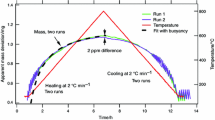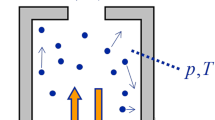Abstract
Ingredients used in the manufacture of perfumes can be investigated by thermogravimetry. In this study the evaporation of methyl benzoate was investigated using a simultaneous TG-DTA unit. A rising temperature method of thermal analysis was used for the study. The rate of evaporation of the ingredient was calculated from a simple plot of percentage mass lossvs. time. A derivative plot of the same was used to calculate the coefficient of evaporation in a controlled atmosphere and regulated air flow rate. In a series of programmed temperature runs on the TGDTA unit it was shown that the evaporation process is zero order, and that the evaporation coefficients at each temperature can be fitted into the Arrhenius equation. The energy of activation, Eact can be calculated from the slope of the line. It was found to be 47 kJ mol−1. This value was compared and shown to approach the enthalpy of vaporization as calculated using the Troutons or Clausius Clapeyron equation
Similar content being viewed by others
References
R. J. Leibrand and B. D. Quimby, Perfumer and Flavorist, 19 (1994) 25.
M. L. Hagedorne, J. Agr. Food Chem, 40 (1992) 634.
D. Walker, K. D. Bartle, D. Breen, A. A. Clifford and S. Costious, Analyst, 119 (1994) 2789.
M. Brown, Introduction to thermal analysis, 2nd ed., Chapman and Hall, London 1988, p. 50.
C. J. Keattch and D. Dollimore, An Introduction to thermogravimetry, 2nd ed.; Heyden, London 1975, p. 164.
R. R. Calkin and J. Stephan, Perfumery Practice and Principles, John Wiley and Sons, Inc., New York 1994, p. 277.
K. Bauer, D. Garbe and H. Surburg, Common Fragrance and Flavor Materials, 2nd ed.; VCH publishers, New York 1990, p. 218.
D. Dollimore, T. A. Evans, Y. F. Lee and F. W. Wilburn, Thermochim. Acta, 198 (1992) 249.
R. M. Stephenson and S. Malanowski, Handbook of the Thermodynamics of Organic Compounds, Elsevier Science publishing Co. Inc., New York 1987, p. 552.
V. Majer, V. Svoboda and J. Pick, Heats of Vaporization of fluids, Elsevier, New York 1989, p. 344.
Author information
Authors and Affiliations
Rights and permissions
About this article
Cite this article
Aggarwal, P., Dollimore, D. & Alexander, K. The use of thermogravimetry to follow the rate of evaporation of an ingredient used in perfumes. Journal of Thermal Analysis 49, 595–599 (1997). https://doi.org/10.1007/BF01996741
Issue Date:
DOI: https://doi.org/10.1007/BF01996741




